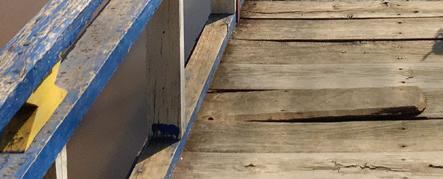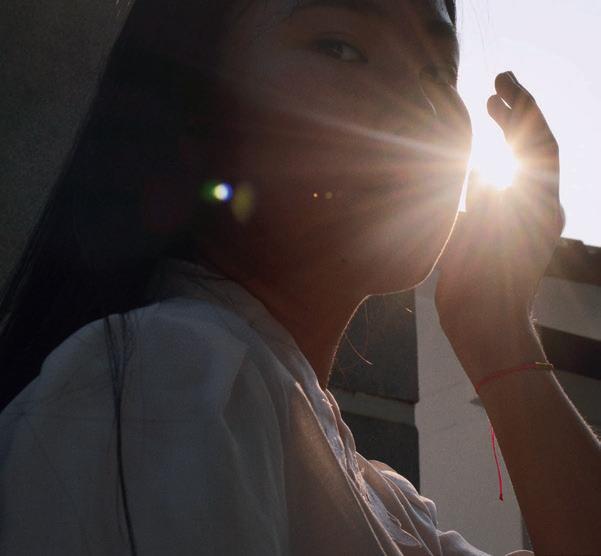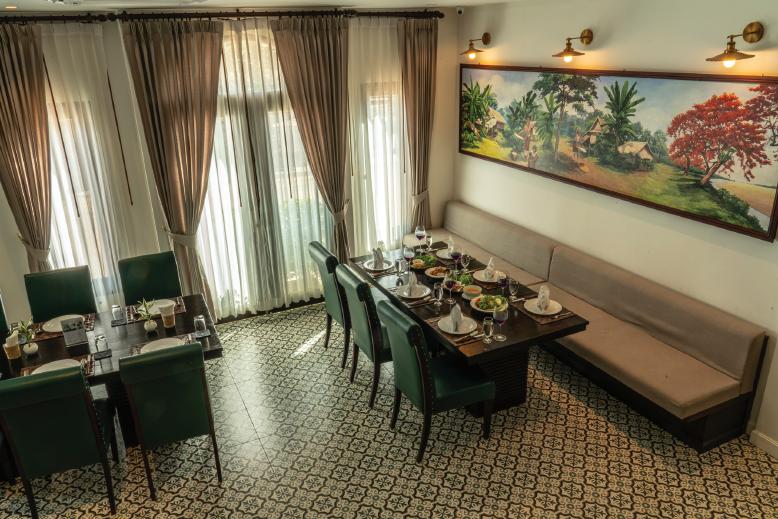
5 minute read
The Charms of Champhone


Advertisement

Venture off the beaten path into the nature and culture of Savannakhet.
Sometimes the best things are found where you least expect them. Savannakhet is the most populous province in Laos, yet also one of the least explored, as tourists seldom stray from the pleasant and scenic downtown area of the city. On a recent visit, I was advised to get out and see the real Savannakhet on the Champhone Circuit. To fi nd out what I was missing, I acquired some transport and headed out of town. TEXT BY JASON ROLAN PHOTOGRAPHS BY PHOONSAB THEVONGSA / JASON ROLAN above: The Library at Wat Ban Lam Chan 1. Murals and archways at Wat Taleo Kao 2. A sacred softshell turtle 3. Remnants of a temple structure at Wat Taleo Kao 4. Monkeys at Dong Ling
Champhone District is quite fl at and agrarian. It is marked by the Xe Champhone River which fl ows from mountains in the north down into the Xe Bang Hiang and onward into the Mekong. My fi rst stop along this route was to admire the wide Soui Reservoir, jokingly called “the ocean of Savannakhet” which contains water for use in the area. It is a charming lake and popular spot on weekends for local people who fl ock to restaurants on the lakeside and enjoy fresh catches of fi sh and shellfi sh. Driving on a few kilometers, the driver stops. “Monkeys!” he exclaims. We have arrived in Dong Ling – “Monkey Forest”. These rare animals live in a forest believed to be sacred by local people, so they are given free rein. Local shops must protect them
selves with metal grating, or the cheeky monkeys will steal things and disappear into the forest. I bought a few bunches of bananas and tried to make friends. They were shy at fi rst, but as more and more monkeys approached, I became uneasy and tossed the bunch at them, before jumping back into the van.
Crossing the Xe Champhone River and on to the next village, we came across a real marvel of Lao architecture, Wat Ban Lam Chan. This ancient temple in Lam Chan Village is quite famous for its incredibly tall stilted Ho Tay Pidok library. Traditionally temple manuscripts were etched into palm leaves and bound together into books. As insects love to eat these leaves, libraries were often built on stilts in ponds, so they would be protected from pests. Sadly, many of these grand wooden structures have been lost and this is one of the few remaining. The manuscripts stored here are of such good quality that they are still regularly studied by academics.
Our next stop was another fascinating natural attraction in Don Daeng Village, a lake with sacred softshell turtles! The villagers nearby believe that anyone who disturbs these animals will mysteriously fall sick or die. Visitors often bring traditional Lao snacks to feed the turtles and avoid any bad luck. Local children nearby have a special way of calling the turtles to the surface to get a snack and are happy to help bring them up. A few children followed me and one of them called out in Lao. A turtle appeared, grabbed the food I offered, and then disappeared back into the murky depths. There is also a small
1
2
GETTING THERE Champhone District is located about 45 kilometers southeast of Savannakhet’s downtown area and road conditions can be quite rugged and dusty, so transport with high clearance is recommended. Lao Airlines has regular fl ights to Savannakhet from Pakse, Bangkok, and Vientiane.

4 3


Buddhist shrine built in the middle of the lake, but due to local beliefs, only men are allowed inside. Just a few kilometers north is a striking piece of Lao-Indochinese architecture stained by modern history and one of my favorite stops on this route. In Taleo Village stand the remnants of an old abandoned temple, Wat Taleo Kao. Built about a century ago, the temple was the target of American bombs in 1969 and many of the structures in the temple grounds did not survive. Thankfully, one building remains and houses a trove of folk art paintings on its walls, telling local legends and stories of the Buddha’s life. Temples are not made like this anymore, as Lao people prefer more modern styles of art on their walls, so seeing this one in its original state was quite a treat, if it were not for the sad reason it was abandoned.
The Champhone Circuit really opened up this section of Laos and showed me a great diversity of fascinating historical and natural places. Visitors to the area should look beyond the city center – get out and see the real charms of Savannakhet!



1


@ Café Mademoiselle (Alliance Française-BKK) @ toineinbangkok (SO Sofitel BKK) @ Flagship Store (Behind WatOngTeu-VTE) @ Settha Palace (VTE) Available

3


18k Gold Jewelry
Vientiane, Lao PDR Artisan
Designer

到达: Champhone区位于沙湾 拿吉市区东南约45公里,路况崎 岖多尘,因此建议轻装上阵。老挝 航空有定期航班从巴色,曼谷和 万象飞往沙湾拿吉。
1. Lam Chan村寺庙图书馆 2. Dong Ling 猴子

CHAMPHONE 的魅力 沙湾拿吉风光及文化的冒险之旅 翻译 : 尹航 图片: PHOONSAB THEVONGSA

2
有时,最好的东西会在您最不经意间遇到。沙湾拿吉是老 挝人口最多的省份,但也是被人们探索最少的省份之一, 因为游客很少从城市宜人且风景秀丽的市区先向周边远 行。最近一次到沙湾拿吉,我被建议到周边走走,走出去, 去Champhone环路看看真正的沙湾拿吉。为了遇见我 错过的景色,我找了辆交通工具,出城了。 Champhone区很平坦,农业发达。它以Xe Champhone 河为标志,该河源于北部的山脉流入Xe Bang Hiang 直 至湄公河。沿着这条路线的第一站我选择了开阔的苏伊 水库,这个水库被戏称为“沙湾拿吉特的海洋”,该水库给 整个区域提供用水。对于当地人来说,这是一个迷人的湖 泊,周末很受游客欢迎,他们涌向湖畔的餐馆,享用新鲜 的鱼类和贝类。 在行驶了几公里后,驾驶员停了下来。 “猴子!”他喊道。我 们到达了东陵-“猴子森林”。这些稀有动物生活在被当地 人认为是神圣的森林中,因此他们可以自由活动。当地商 店必须用金属栅栏将商店围起来,否则厚脸皮的猴子会 偷东西然后讨回森林。我买了几束香蕉,并试图和他们交 朋友。他们起初很害羞,但是随着越来越多猴子靠近,我 感到了不安,把一整把香蕉都扔给了他们,然后赶快跳上 车离开。 穿过Xe Champhone河到达下一个村庄,我们遇到了令 人惊叹的老挝建筑奇迹,Wat Ban Lam Chan。位于Lam Chan村的这座古庙以其高不可攀的Ho Tay Pidok图书 馆而闻名。古时候,寺庙手稿是在棕榈叶上雕刻的,然后 装订成书。由于昆虫喜欢吃这些叶子,因此图书馆通常建 在池塘的高跷上以保护它们免受害虫侵害。可悲的是,许 多宏伟的木结构建筑已丢失,只剩余的少许几个。这里存 储的手稿质量很高,老挝和外国学者仍在定期研学它们。 我们的下一站是位于Don Daeng村的另一个自然景点, 这里的湖泊住着神圣的软壳龟!附近的村民相信,任何干 扰这些动物的人都会神秘地生病或死亡。访客经常携带 传统的老挝小吃来喂这些软壳龟以祈求平安顺利。当地 儿童有一种特殊的本事,可以将软壳龟叫到水面,喂他们 小吃,帮助幼龟成长。几个孩子跟着我,其中一个用老挝 语大喊,瞬间一只软壳龟出现了,叼走了我们提供的食 物,消失在深暗的湖面。湖中还建有一座小型佛教圣地, 但由于当地的信仰,只允许男性进入。 向北几公里有一座引人注目的老挝-印度支那建筑,虽被 现代历史所染,依然是我在这条路线上最喜欢的停留点 之一。在塔莱欧村(Taleo Village)可以看到古老的废弃 寺院-塔莱古高寺(Wat Taleo Kao)的废墟。这座寺庙建 于大约一个世纪前,也是1969年美国轰炸的目标之一,寺 庙的许多建筑物都没有幸存。值得庆幸的是,一幢建筑物 保留了下来,墙上还藏着许多民间艺术画作,讲述了当地 的传说和佛陀生平的故事。现在寺庙的建造与以往已经 不一样了,老挝人现在更喜欢在墙壁上使用更现代的艺 术风格,因此,如果不是处于不得已的原因而放弃它,那 么看到它的原始状态实在是一种享受。 Champhone环线确实向我们展示了老挝一部分悠久的 历史和自然景观。该地区的游客应该把目光投向市中心 以外的地方-走出去,去看看沙湾拿吉真正的魅力!


















